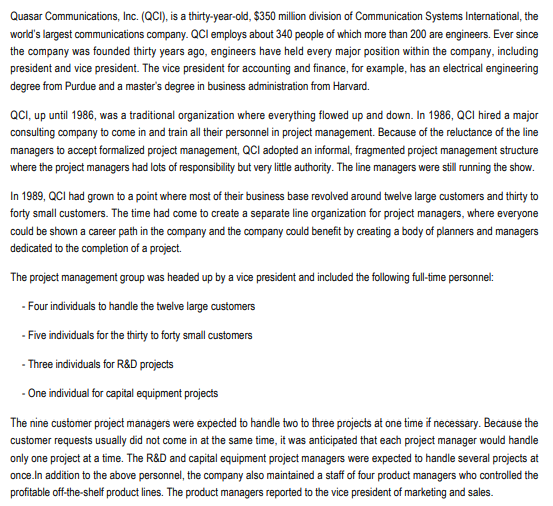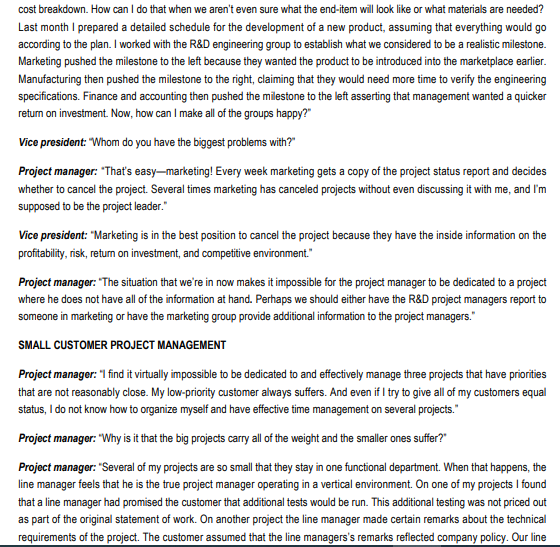cost breakdown. How can I do that when we aren't even sure what the end-item will look like or what materials are needed? Last month I prepared a detailed schedule for the development of a new product, assuming that everything would go according to the plan. I worked with the R&D engineering group to establish what we considered to be a realistic milestone. Marketing pushed the milestone to the left because they wanted the product to be introduced into the marketplace earlier. Manufacturing then pushed the milestone to the right, claiming that they would need more time to verify the engineering specifications. Finance and accounting then pushed the milestone to the left asserting that management wanted a quicker return on investment. Now, how can I make all of the groups happy?" Vice president: "Whom do you have the biggest problems with?" Project manager: "That's easy-marketing! Every week marketing gets a copy of the project status report and decides whether to cancel the project. Several times marketing has canceled projects without even discussing it with me, and I'm supposed to be the project leader." Vice president: "Marketing is in the best position to cancel the project because they have the inside information on the profitability, risk, return on investment, and competitive environment." Project manager: "The situation that we're in now makes it impossible for the project manager to be dedicated to a project where he does not have all of the information at hand. Perhaps we should either have the R&D project managers report to someone in marketing or have the marketing group provide additional information to the project managers." SMALL CUSTOMER PROJECT MANAGEMENT Project manager: "I find it virtually impossible to be dedicated to and effectively manage three projects that have priorities that are not reasonably close. My low-priority customer always suffers. And even if I try to give all of my customers equal status, I do not know how to organize myself and have effective time management on several projects." Project manager: "Why is it that the big projects carry all of the weight and the smaller ones suffer?" Project manager: "Several of my projects are so small that they stay in one functional department. When that happens, the line manager feels that he is the true project manager operating in a vertical environment. On one of my projects I found that a line manager had promised the customer that additional tests would be run. This additional testing was not priced out as part of the original statement of work. On another project the line manager made certain remarks about the technical requirements of the project. The customer assumed that the line managers's remarks reflected company policy. Our line
cost breakdown. How can I do that when we aren't even sure what the end-item will look like or what materials are needed? Last month I prepared a detailed schedule for the development of a new product, assuming that everything would go according to the plan. I worked with the R&D engineering group to establish what we considered to be a realistic milestone. Marketing pushed the milestone to the left because they wanted the product to be introduced into the marketplace earlier. Manufacturing then pushed the milestone to the right, claiming that they would need more time to verify the engineering specifications. Finance and accounting then pushed the milestone to the left asserting that management wanted a quicker return on investment. Now, how can I make all of the groups happy?" Vice president: "Whom do you have the biggest problems with?" Project manager: "That's easy-marketing! Every week marketing gets a copy of the project status report and decides whether to cancel the project. Several times marketing has canceled projects without even discussing it with me, and I'm supposed to be the project leader." Vice president: "Marketing is in the best position to cancel the project because they have the inside information on the profitability, risk, return on investment, and competitive environment." Project manager: "The situation that we're in now makes it impossible for the project manager to be dedicated to a project where he does not have all of the information at hand. Perhaps we should either have the R&D project managers report to someone in marketing or have the marketing group provide additional information to the project managers." SMALL CUSTOMER PROJECT MANAGEMENT Project manager: "I find it virtually impossible to be dedicated to and effectively manage three projects that have priorities that are not reasonably close. My low-priority customer always suffers. And even if I try to give all of my customers equal status, I do not know how to organize myself and have effective time management on several projects." Project manager: "Why is it that the big projects carry all of the weight and the smaller ones suffer?" Project manager: "Several of my projects are so small that they stay in one functional department. When that happens, the line manager feels that he is the true project manager operating in a vertical environment. On one of my projects I found that a line manager had promised the customer that additional tests would be run. This additional testing was not priced out as part of the original statement of work. On another project the line manager made certain remarks about the technical requirements of the project. The customer assumed that the line managers's remarks reflected company policy. Our line
Practical Management Science
6th Edition
ISBN:9781337406659
Author:WINSTON, Wayne L.
Publisher:WINSTON, Wayne L.
Chapter11: Simulation Models
Section11.4: Marketing Models
Problem 30P: Seas Beginning sells clothing by mail order. An important question is when to strike a customer from...
Related questions
Question
100%

Transcribed Image Text:Quasar Communications, Inc. (QCI), is a thirty-year-old, $350 million division of Communication Systems International, the
world's largest communications company. QCI employs about 340 people of which more than 200 are engineers. Ever since
the company was founded thirty years ago, engineers have held every major position within the company, including
president and vice president. The vice president for accounting and finance, for example, has an electrical engineering
degree from Purdue and a master's degree in business administration from Harvard.
QCI, up until 1986, was a traditional organization where everything flowed up and down. In 1986, QCI hired a major
consulting company to come in and train all their personnel in project management. Because of the reluctance of the line
managers to accept formalized project management, QCI adopted an informal, fragmented project management structure
where the project managers had lots of responsibility but very little authority. The line managers were still running the show.
In 1989, QCI had grown to a point where most of their business base revolved around twelve large customers and thirty to
forty small customers. The time had come to create a separate line organization for project managers, where everyone
could be shown a career path i company and company could benefit by creating a body of planners and managers
dedicated to the completion of a project.
The project management group was headed up by a vice president and included the following full-time personnel:
- Four individuals to handle the twelve large customers
- Five individuals for the thirty to forty small customers
- Three individuals for R&D projects
- One individual for capital equipment projects
The nine customer project managers were expected to handle two to three projects at one time if necessary. Because the
customer requests usually did not come in at the same time, it was anticipated that each project manager would handle
only one project at a time. The R&D and capital equipment project managers were expected to handle several projects at
once. In addition to the above personnel, the company also maintained a staff of four product managers who controlled the
profitable off-the-shelf product lines. The product managers reported to the vice president of marketing and sales.

Transcribed Image Text:cost breakdown. How can I do that when we aren't even sure what the end-item will look like or what materials are needed?
Last month I prepared a detailed schedule for the development of a new product, assuming that everything would go
according to the plan. I worked with the R&D engineering group to establish what we considered to be a realistic milestone.
Marketing pushed the milestone to the left because they wanted the product to be introduced into the marketplace earlier.
Manufacturing then pushed the milestone to the right, claiming that they would need more time to verify the engineering
specifications. Finance and accounting then pushed the milestone to the left asserting that management wanted a quicker
return on investment. Now, how can I make all of the groups happy?"
Vice president: "Whom do you have the biggest problems with?"
Project manager: "That's easy-marketing! Every week marketing gets a copy of the project status report and decides
whether to cancel the project. Several times marketing has canceled projects without even discussing it with me, and I'm
supposed to be the project leader."
Vice president: "Marketing is in the best position to cancel the project because they have the inside information on the
profitability, risk, return on investment, and competitive environment."
Project manager: "The situation that we're in now makes it impossible for the project manager to be dedicated to a project
where he does not have all of the information at hand. Perhaps we should either have the R&D project managers report to
someone in marketing or have the marketing group provide additional information to the project managers."
SMALL CUSTOMER PROJECT MANAGEMENT
Project manager: "I find it virtually impossible to be dedicated to and effectively manage three projects that have priorities
that are not reasonably close. My low-priority customer always suffers. And even if I try to give all of my customers equal
status, I do not know how to organize myself and have effective time management on several projects."
Project manager: "Why is it that the big projects carry all of the weight and the smaller ones suffer?"
Project manager: "Several of my projects are so small that they stay in one functional department. When that happens, the
line manager feels that he is the true project manager operating in a vertical environment. On one of my projects I found
that a line manager had promised the customer that additional tests would be run. This additional testing was not priced out
as part of the original statement of work. On another project the line manager made certain remarks about the technical
requirements of the project. The customer assumed that the line managers's remarks reflected company policy. Our line
Expert Solution
This question has been solved!
Explore an expertly crafted, step-by-step solution for a thorough understanding of key concepts.
Step by step
Solved in 4 steps

Recommended textbooks for you

Practical Management Science
Operations Management
ISBN:
9781337406659
Author:
WINSTON, Wayne L.
Publisher:
Cengage,

Marketing
Marketing
ISBN:
9780357033791
Author:
Pride, William M
Publisher:
South Western Educational Publishing

Practical Management Science
Operations Management
ISBN:
9781337406659
Author:
WINSTON, Wayne L.
Publisher:
Cengage,

Marketing
Marketing
ISBN:
9780357033791
Author:
Pride, William M
Publisher:
South Western Educational Publishing